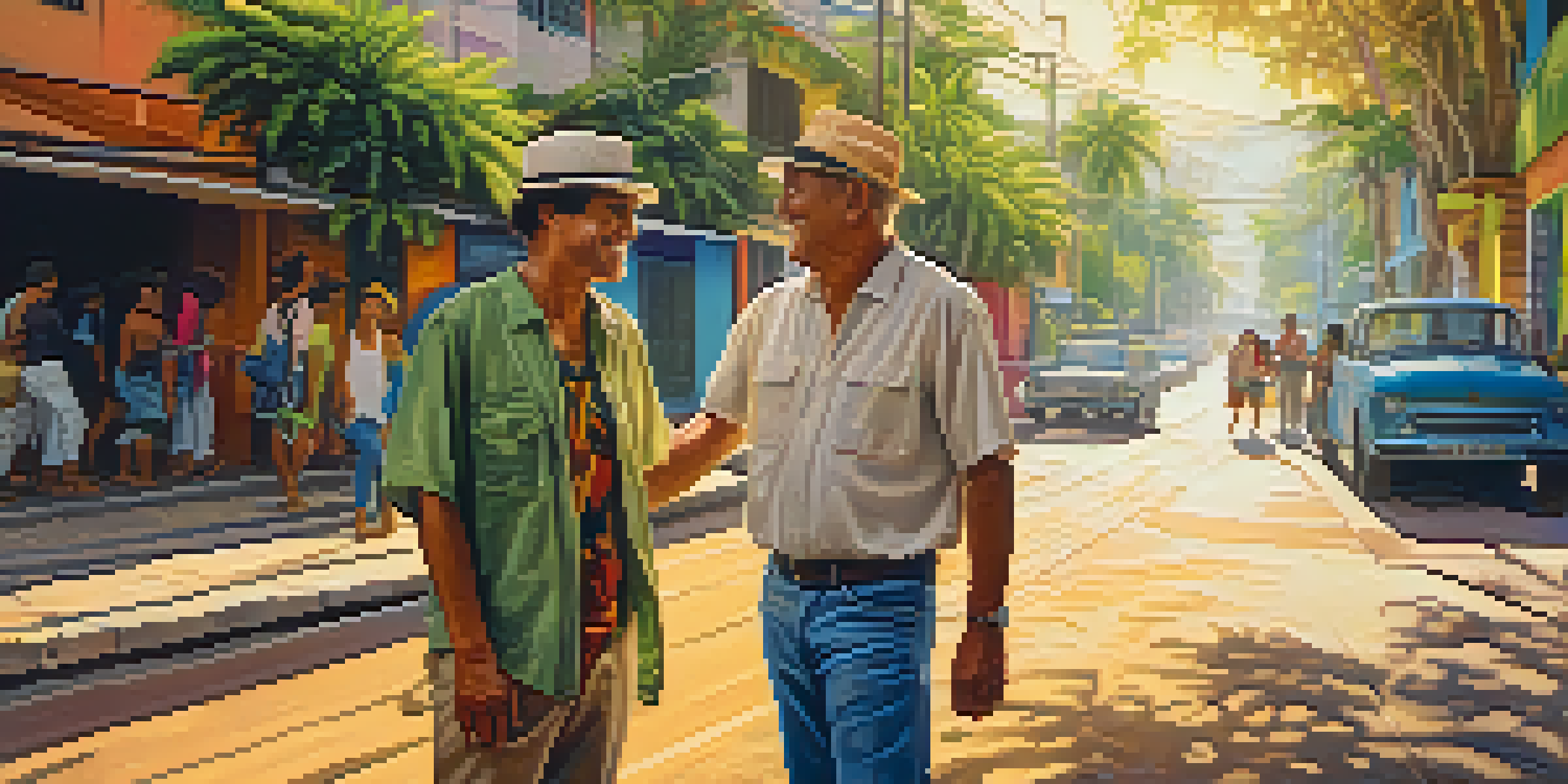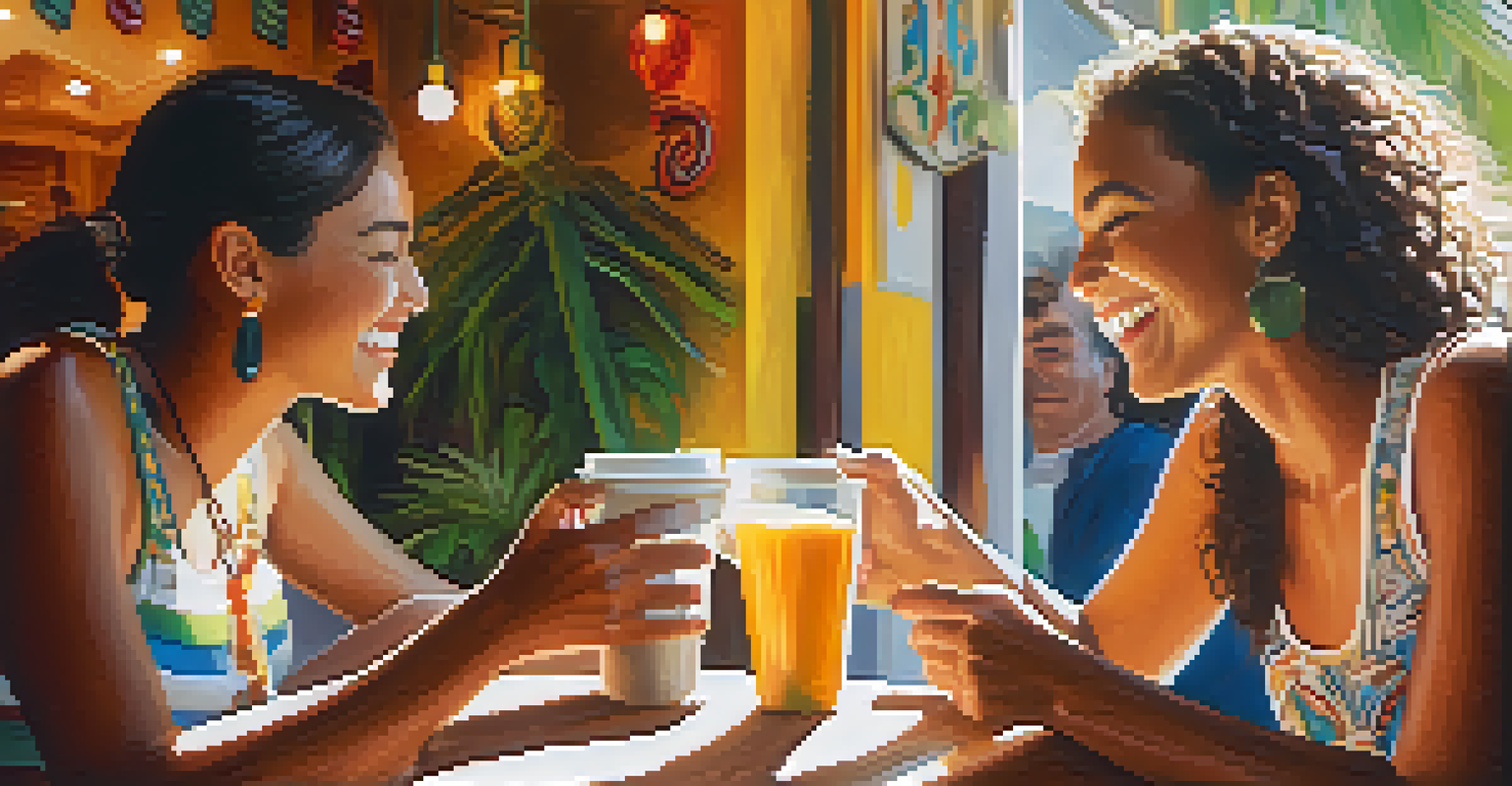Understanding Brazilian Greetings: A Guide for Tourists

The Importance of Greetings in Brazilian Culture
In Brazil, greetings are more than just a polite exchange; they reflect the warmth and friendliness of its people. A simple 'olá' can open doors to meaningful interactions, making you feel more at home in this vibrant country. Greetings often set the tone for relationships, whether you're meeting someone for the first time or reconnecting with a friend.
A smile is the universal welcome.
Understanding the cultural significance of greetings can greatly enhance your travel experience. Brazilians value personal connections, and a friendly greeting can help establish rapport and trust. So, when you greet someone, you are not just being polite; you are engaging in a cultural practice that is deeply valued.
As a tourist, embracing this aspect of Brazilian culture can lead to richer experiences. By taking the time to greet others warmly, you may find that people are more open and willing to share their stories, culture, and even travel tips. It's an invitation to connect on a deeper level.
Common Brazilian Greetings You Should Know
Brazil offers a variety of greetings that reflect its diverse culture. The most common is 'olá,' which is equivalent to 'hello' and can be used in most situations. Another familiar greeting is 'oi,' a more casual way to say 'hi,' often used among friends or younger people.

When meeting someone for the first time, a handshake is typical, accompanied by a friendly smile. In more informal settings, you might hear 'e aí?' which translates to 'what's up?' This greeting is popular among friends and is a great way to break the ice. Familiarizing yourself with these phrases can help you navigate social situations with ease.
Know Your Greetings: Formal vs. Informal
Understanding when to use formal or informal greetings is essential for navigating social situations in Brazil.
Don’t forget to consider the regional variations; for instance, in the northeastern states, you might hear 'como você tá?' meaning 'how are you?' This is a friendly way to show interest in someone's well-being. Using these greetings can make your interactions more genuine and enjoyable.
The Role of Physical Contact in Brazilian Greetings
Physical contact is an essential part of Brazilian greetings, often signifying warmth and familiarity. A handshake is common, but as you get to know someone better, you might encounter hugs or even cheek kisses. These gestures vary by region, so it's helpful to observe and follow the lead of your Brazilian counterparts.
The way we greet each other says a lot about who we are as individuals and as a culture.
In some areas, such as Rio de Janeiro, it is common to greet friends with two kisses on the cheek, starting from the right. In contrast, in São Paulo, one kiss is often sufficient. Understanding these nuances can help you avoid awkward moments and show respect for local customs.
Additionally, maintaining eye contact during greetings is important in Brazilian culture, as it conveys sincerity and interest. Embracing this aspect of communication can foster stronger connections and make your interactions more meaningful.
How to Respond to Greetings in Brazil
Responding to greetings in Brazil is just as important as initiating them. A simple 'Olá, tudo bem?' meaning 'Hello, everything good?' is a great way to reciprocate. This phrase not only answers the greeting but also invites further conversation, showing that you're genuinely interested in the other person.
If someone asks how you are, it's customary to respond with 'Tudo bem, e você?' which translates to 'Everything is good, and you?' This back-and-forth exchange is an integral part of Brazilian communication and reflects the culture’s emphasis on friendliness.
Greetings Reflect Brazilian Warmth
In Brazil, greetings are a vital cultural practice that fosters connection and conveys friendliness.
Remember, it’s all about the tone and warmth of your response. A cheerful demeanor can go a long way in making your interactions enjoyable, and it often leads to more in-depth conversations. By practicing these responses, you'll feel more at ease in social situations.
Greetings in Different Contexts: Formal vs. Informal
In Brazil, the context of your interaction often dictates the type of greeting used. In formal settings, such as business meetings, a firm handshake and a polite 'Bom dia' (Good morning) or 'Boa tarde' (Good afternoon) are appropriate. This shows respect and professionalism.
Conversely, in informal situations, especially among friends and family, greetings become more relaxed and personal. You might hear 'Oi, beleza?' meaning 'Hi, all good?' which conveys a casual tone. Understanding when to use formal versus informal greetings is key to navigating social situations effectively.
Being mindful of the context not only helps you fit in but also demonstrates cultural sensitivity. Brazilians appreciate when visitors make an effort to understand their social norms, and this can pave the way for more meaningful interactions.
Cultural Nuances in Brazilian Greetings
Brazilian culture is rich with nuances, especially when it comes to greetings. For instance, the level of familiarity can dictate how you greet someone. Close friends might greet with warmth and exuberance, while acquaintances may opt for a more reserved approach.
Additionally, regional variations play a significant role in how greetings are expressed. In Bahia, for example, you might encounter a more laid-back style, while in the south, greetings might be more formal. Being aware of these differences can enhance your interactions and show your appreciation for local customs.
Greetings Foster Connections in Brazil
In Brazil, greetings go beyond mere politeness, serving as a vital means to establish warmth and trust in interactions.
In some cases, greetings can also reflect social status or age. Younger people often adopt more casual greetings, while older individuals might prefer a more traditional approach. Observing these dynamics can help you navigate social situations with greater ease.
Tips for Practicing Brazilian Greetings
Practicing Brazilian greetings can be a fun way to immerse yourself in the culture. Start by learning common phrases and practicing them in front of a mirror or with friends. The more you practice, the more comfortable you'll feel when greeting locals.
Consider engaging with Brazilian media, such as music, movies, or TV shows, to hear the greetings in context. This can help you pick up on intonation and body language, which are crucial in making your greetings feel authentic.

Lastly, don’t be afraid to make mistakes! Brazilians are generally understanding and appreciate when foreigners make an effort to speak their language. Embracing this learning process can lead to memorable experiences and connections during your travels.